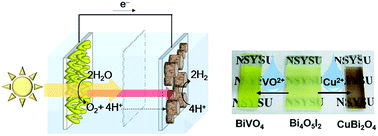A tandem photoelectrochemical water splitting cell consisting of CuBi2O4 and BiVO4 synthesized from a single Bi4O5I2 nanosheet template†
Abstract
We report on a simple and facile synthetic approach for preparing both a CuBi2O4 photocathode and BiVO4 photoanode from a single Bi4O5I2 nanosheet template. A nanosheet structured Bi4O5I2 (nanoBi4O5I2) template, solvothermally deposited on a conducting glass substrate, can be converted to a textured CuBi2O4 photocathode and a BiVO4 photoanode with coral-like nanostructure by drop-casting a copper ion-containing and a vanadium ion-containing solution, respectively, with a follow-up heat treatment. UV-vis absorption spectra and Mott–Schottky analyses confirm CuBi2O4 and BiVO4 have well-suited band gaps for absorbing a large portion of visible light and complementary band structures for proton reduction and water oxidation, respectively. A photoelectrochemical tandem cell, consisting of a cobalt based catalyst modified CuBi2O4 photocathode and a cobalt based catalyst modified BiVO4 photoanode shows promising photoelectrochemical properties towards water splitting, and can be operated without an external bias. Factors limiting the performance of the tandem cell are also discussed.

- This article is part of the themed collection: Artificial photosynthesis


 Please wait while we load your content...
Please wait while we load your content...